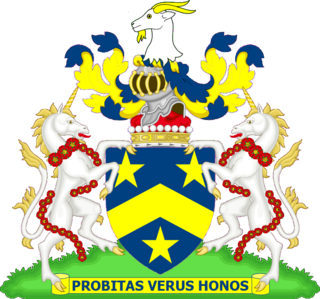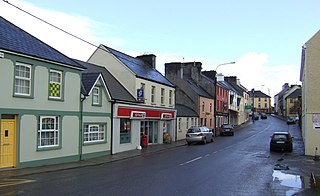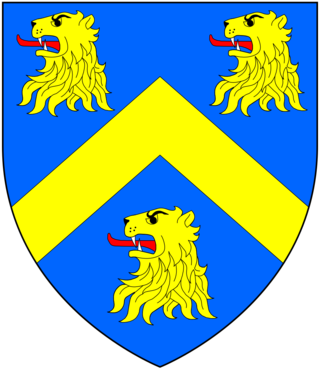
Earl of Limerick is a title that has been created twice in the Peerage of Ireland, associated first with the Dongan family, then with the Pery family. It should not be confused with the title Viscount of the City of Limerick held by the Hamilton family also Earls of Clanbrassil.

Earl of Verulam is a title in the Peerage of the United Kingdom. It was created in 1815 for James Grimston, 4th Viscount Grimston. He was made Viscount Grimston at the same time. Verulam had previously represented St Albans in the House of Commons. In 1808 he had also succeeded his maternal cousin as tenth Lord Forrester. He was succeeded by his son, the second Earl.

Viscount Chetwynd, of Bearhaven in the County of Kerry, is a title in the Peerage of Ireland. It was created in 1717 for Walter Chetwynd, with remainder to the issue male of his father John Chetwynd. He was made Baron Rathdowne, in the County of Dublin, at the same time, also in the Peerage of Ireland and with the same remainder. Chetwynd notably represented Stafford in the House of Commons on three occasions between 1702 and 1734, and also served as ambassador to Turin. He was succeeded according to the special remainders by his younger brother, the second Viscount, who sat as a Member of Parliament for St Mawes, Stockbridge and, from 1738 to 1747 for Stafford and served as ambassador to Madrid.

Viscount Gage, of Castle Island in the County of Kerry of the Kingdom of Ireland, is a title in the Peerage of Ireland. It was created in 1720 for Thomas Gage, along with the subsidiary title of Baron Gage, of Castlebar in the County of Mayo, also in the Peerage of Ireland. In 1744 he also succeeded his cousin as eighth Baronet, of Firle Place. The titles remain united. The Gage family descends from John Gage, who was created a baronet, of Firle Place in the County of Sussex, in the Baronetage of England on 26 March 1622. His great-grandson, the seventh Baronet, represented Seaford in Parliament. He was succeeded by his first cousin, Thomas Gage, 1st Viscount Gage, the eighth Baronet. He sat as a Member of Parliament for Minehead and Tewkesbury and also served as Governor of Barbados. In 1720, 24 years before succeeding in the baronetcy, he was raised to the Peerage of Ireland as Baron Gage and Viscount Gage. His second son was the military commander the Hon. Thomas Gage.

Baron Farnham, of Farnham in the County of Cavan, is a title in the Peerage of Ireland. It was created in 1756 for John Maxwell, who had previously represented Cavan Borough in the Irish House of Commons. John Maxwell's son, the second Baron, was created Viscount Farnham in 1760 and Earl of Farnham in 1763. Both titles were in the Peerage of Ireland but became extinct when he died childless in 1779. His brother and successor, the third Baron, was again created Viscount Farnham in 1781 and Earl of Farnham in 1785. These titles were also in the Peerage of Ireland. His son, the second Earl, sat in the House of Lords as an Irish representative peer from 1816 to 1823. However, he had no children and on his death in 1823 the viscountcy and earldom became extinct.

Earl of Pomfret was a title in the Peerage of Great Britain created in 1721 for Thomas Fermor, 2nd Baron Leominster. The title became extinct upon the death of the fifth earl in 1867.

Milltown is a small town on the N70 national secondary road between the major towns of Tralee and Killarney in County Kerry, Ireland. It is approximately 7 kilometres (4 mi) from Killorglin.

Earl of Egremont was a title in the Peerage of Great Britain. It was created in 1749, along with the subsidiary title Baron of Cockermouth, in Cumberland, for Algernon Seymour, 7th Duke of Somerset, with remainder to his nephews Sir Charles Wyndham, 4th Baronet, of Orchard Wyndham, and Percy Wyndham-O'Brien. The Duke had previously inherited the Percy estates, including the lands of Egremont in Cumberland, from his mother Lady Elizabeth Percy, daughter and heiress of Joceline Percy, 11th Earl of Northumberland. In 1750 Sir Charles Wyndham succeeded according to the special remainder as second Earl of Egremont on the death of his uncle. His younger brother Percy Wyndham-O'Brien was created Earl of Thomond in 1756.

There have been six baronetcies created for persons with the surname Smyth, two in the Baronetage of England, one in the Baronetage of Great Britain, one in the Baronetage of Ireland and two in the Baronetage of the United Kingdom. One creation is extant as of 2010.
There have been six baronetcies created for persons with the surname Brooke, one in the Baronetage of England, one in the Baronetage of Ireland and four in the Baronetage of the United Kingdom. As of 2015 four of the creations are extant, though one has been subsumed into a peerage.

The Spring family is a Suffolk gentry family that has been involved in the politics and economy of East Anglia since the 15th century, as well as holding large estates in Ireland from the 16th century.
The High Sheriff of County Kilkenny was the British Crown's judicial representative in County Kilkenny, Ireland from the 16th century until 1922, when the office was abolished in the new Free State and replaced by the office of Kilkenny County Sheriff. The sheriff had judicial, electoral, ceremonial and administrative functions and executed High Court Writs. In 1908, an Order in Council made the Lord-Lieutenant the Sovereign's prime representative in a county and reduced the High Sheriff's precedence. However, the sheriff retained his responsibilities for the preservation of law and order in the county. The usual procedure for appointing the sheriff from 1660 onwards was that three persons were nominated at the beginning of each year from the county and the Lord Lieutenant then appointed his choice as High Sheriff for the remainder of the year. Often the other nominees were appointed as under-sheriffs. Sometimes a sheriff did not fulfil his entire term through death or other event and another sheriff was then appointed for the remainder of the year. The dates given hereunder are the dates of appointment. All addresses are in County Kilkenny unless stated otherwise.
The High Sheriff of Mayo was the British Crown's judicial representative in County Mayo, Ireland from the 16th century until 1922, when the office was abolished in the new Free State and replaced by the office of Mayo County Sheriff. The sheriff had judicial, electoral, ceremonial and administrative functions and executed High Court Writs. In 1908, an Order in Council made the Lord-Lieutenant the Sovereign's prime representative in a county and reduced the High Sheriff's precedence. However, the sheriff retained his responsibilities for the preservation of law and order in the county. The usual procedure for appointing the sheriff from 1660 onwards was that three persons were nominated at the beginning of each year from the county and the Lord Lieutenant then appointed his choice as High Sheriff for the remainder of the year. Often the other nominees were appointed as under-sheriffs. Sometimes a sheriff did not fulfil his entire term through death or other event and another sheriff was then appointed for the remainder of the year. The dates given hereunder are the dates of appointment. All addresses are in County Mayo unless stated otherwise.
The High Sheriff of Kerry was the British Crown's judicial representative in County Kerry, Ireland from the 16th century until 1922, when the office was abolished in the new Free State and replaced by the office of Kerry County Sheriff. The sheriff had judicial, electoral, ceremonial and administrative functions and executed High Court Writs. In 1908, an Order in Council made the Lord-Lieutenant the Sovereign's prime representative in a county and reduced the High Sheriff's precedence. However, the sheriff retained his responsibilities for the preservation of law and order in the county. The usual procedure for appointing the sheriff from 1660 onwards was that three persons were nominated at the beginning of each year from the county and the Lord Lieutenant then appointed his choice as High Sheriff for the remainder of the year. Often the other nominees were appointed as under-sheriffs. Sometimes a sheriff did not fulfil his entire term through death or other event and another sheriff was then appointed for the remainder of the year. The dates given hereunder are the dates of appointment. All addresses are in County Kerry unless stated otherwise.
The Sheriff of County Dublin was the Sovereign's judicial representative in County Dublin. Initially, an office for a lifetime, assigned by the Sovereign, the Sheriff became an annual appointment following the Provisions of Oxford in 1258. The first recorded Sheriff was Ralph Eure, appointed in that year. The next recorded Sheriff was Sir David de Offington, who was Sheriff in 1282. Besides his judicial importance, the sheriff had ceremonial and administrative functions and executed High Court Writs.

Killagha Abbey of Our Lady of Bello Loco, also called Kilcolman Abbey, is a ruined Augustinian abbey and former manor house in County Kerry, Ireland. The abbey is situated one and a half miles north-west of Milltown on the banks of the River Maine.
Walter Spring the Unfortunate was an Anglo-Irish Roman Catholic landowner involved in the Irish Confederate Wars.
Sir William Duncan Godfrey, 3rd Baronet (1797–1873) was an Anglo-Irish aristocrat and landowner.
Sir William Godfrey, 1st Baronet (1739–1817) was an Anglo-Irish member of the Irish House of Commons.
Thomas Spring of Castlemaine was an English Protestant soldier, politician and Constable of Castle Maine in County Kerry, Ireland.










